At the end of this chapter, you will be able to:
- identify equipment needed for suctioning
Whichever method of suctioning you use, you should first be comfortable setting up the suction machine, gathering your equipment and knowing which size catheter(s) to use for your child’s tracheostomy tube.
What equipment do I need for suctioning?
You will need the following equipment:
- suction catheters
- Yankauer
- suction machine
- sterile distilled water for rinsing
- manual suction setup
- hand sanitizer
- gloves
- mask and eye protector
- emergency tracheostomy kit

Emergency tracheostomy kit
- Tracheostomy tube with ties attached and obturator of same size.
- One size smaller tracheostomy tube with ties attached and obturator (store in a small, well-labelled, clear bag).
- Normal saline nebules.
- Water soluble lubricant.
- Extra inner cannula, if needed.
- Round-ended scissors.
- Pre-cut tracheostomy gauze.
- Manual suction setup: 20 mL syringe with feeding tube attached (in case the suction machine malfunctions).
- One size down feeding tube for smaller sized backup tracheostomy tube, if needed.
- Sterile water, syringe and cup for cuffed tracheostomy tube if your child has one that requires either water or air in the cuff (for air you only need the syringe).
Additional equipment and supplies
- Suction machine, tubing and adjuncts.
- Sterile, distilled water.
- Clean container for flushing solution.
- Clean disposable gloves (to avoid direct contact with secretions or organisms from your child; sterile gloves are not needed).
- Hand sanitizer.
- Good light source.
- Oximeter and probes.
- Manual resuscitation bag with tracheostomy adaptor and the appropriately sized mask and stoma mask (if prescribed).
- Oxygen, if needed.
- Plastic bag.
What to look for when checking equipment
- Check your equipment every day to make sure that the:
- suction pressure is set to appropriate levels
- filter is clean
- suction tubing is clean
- canister is emptied and clean
- machine is plugged into A/C power and internal battery is charged
- Check the size and measure the suction catheter.
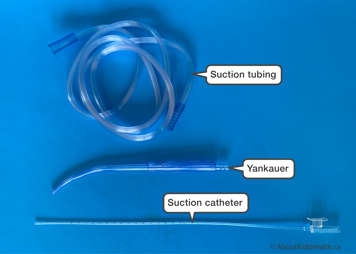
Different catheters may be used for nasal, oral, nasopharyngeal, oropharyngeal, tracheostomy tip, tube and deep suctioning.
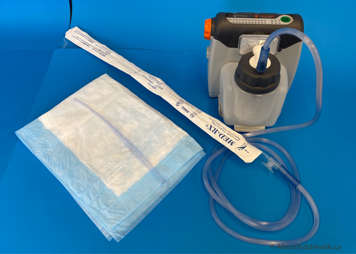
Parts of a suction catheter
- Number markings
- Eyelets
- Thumb port
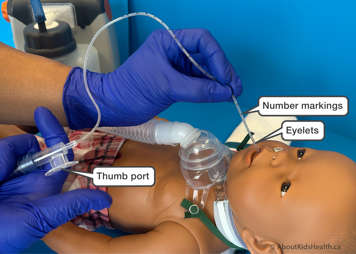
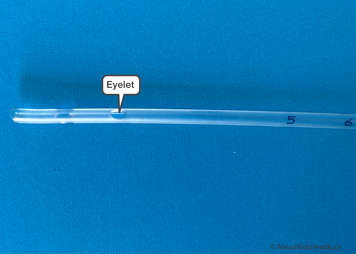
How do I know the right size catheter for my child?
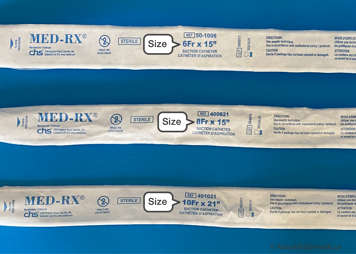
Your child’s health-care provider will review with you what type of tube and suction catheter your child needs, how far to insert the suction catheter and which setting to use for the suction machine.
Please make note of the catheter size and the required pressure setting on the suction machine. Do not increase the suction pressure past what is prescribed for your child.
Ensure you are using the largest 'Fr' size that fits easily into your child’s tracheostomy tube. This will allow you to suction more secretions.
Size of suction catheter(s) to be used: __________ and __________ French (Fr)
Suction machine pressure: __________ mmHg
Please note: You may need two different sizes of suction catheter for the same size tracheostomy tube and then one size down tube.
In general, the recommended suction catheter sizes depend on the inner diameter of the tracheostomy tube.
| Correct suction catheter size | |
|---|---|
| Tracheostomy tube size (mm) | Recommended suction catheter size (Fr) |
| 3.0 | 6 |
| 3.5 | 8 |
| 4.0 | 8 |
| 4.5 | 10 |
| 5.0 | 10 |
| 6.0 | 12 |
| 7.0 | 14 |
Important
Suction catheters should never be cut to size. The end of the catheter will become uneven and can cause damage to the lining of the trachea.
Identifying the correct suction depth for tracheostomy tube suctioning
Tube suctioning involves removing mucus from the full length of the tracheostomy tube, including just past the far end of the tube. This is a pre-measured length and depends on the length of your child’s tracheostomy tube. There are two methods to identify the correct suctioning depth for routine tube suctioning.
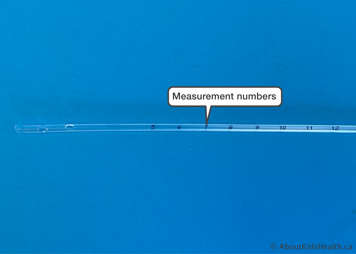
Method 1: Using the obturator as a guide
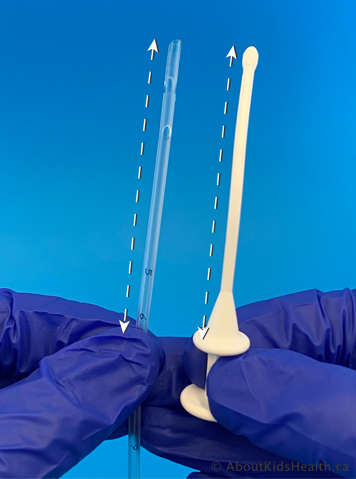
- Use the obturator or spare tracheostomy tube the same length as your child’s tube and a measuring tape.
- Measure the distance from the tracheostomy tube connector to the end of the tracheostomy tube or the obturator measurement as shown below.
- Record the suction depth on a tape measure.
- Attach the tape measure to the cot/bedside/suction machine for future use.
Method 2: Using the same size back-up tracheostomy tube as a guide
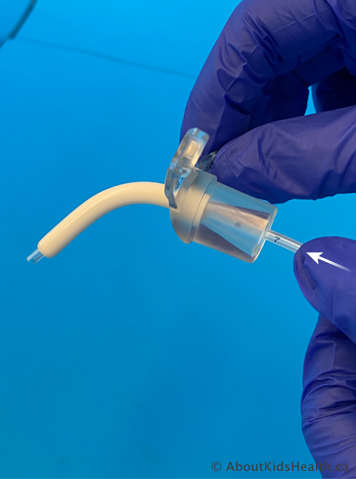
You can also measure the correct tube suctioning depth by placing a clean suction catheter inside a back-up tracheostomy tube of the same size as the one your child is currently wearing. The suction catheter should come out the end of the tube by a short amount (as pictured). Measure the suction catheter at the hub of the tube.
Important
Ensure you do not touch the shaft of the obturator or tube so that it stays clean.
| Fill in your child’s information here: | |
|---|---|
| Tracheostomy tube size (same size that child has in place): | |
| One size down tracheostomy tube size: | |
| Suction catheter size for the same size tracheostomy tube: | |
| Suction catheter size for the one size down tracheostomy tube: | |
| Depth of suction catheter insertion for same size tube: | |
| Depth of suction catheter insertion for one size down tube: | |
| Suction machine pressure setting: | |
Note: This applies to the manual suction sizing as well.